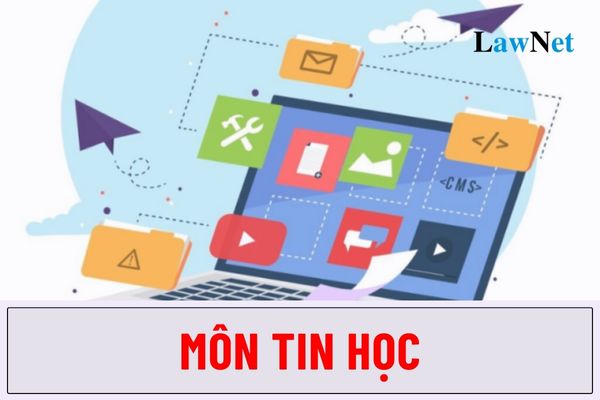Vietnam: According to the latest curriculum, starting from which grade do students begin computer science?
According to the latest curriculum, from which grade do students start learning Informatics?
Based on Subsection 1, Section 4 of the General Program of the General Education Curriculum issued together with Circular 32/2018/TT-BGDDT, it is clearly stated that Informatics is taught starting from grade 3.
According to Official Dispatch 816/BGDDT-GDTH in 2022, implementing the General Education Curriculum in Circular 32/2018/TT-BGDDT, Informatics will be a compulsory subject taught from grade 3 starting in the 2022 - 2023 academic year.
Thus, according to the latest curriculum, students will start learning Informatics from grade 3.
>> View the General Program of the General Education Curriculum issued together with Circular 32/2018/TT-BGDDT: Download

According to the latest curriculum, from which grade do students start learning Informatics? (Image from the Internet)
What are the objectives of Informatics education at the primary school level of the curriculum?
Based on Subsection 2, Section 3 of the General Education Curriculum for Informatics issued together with Circular 32/2018/TT-BGDDT, the objectives of Informatics education at the primary school level are as follows:
- The Informatics curriculum at the primary level helps students initially become familiar with digital technology, start developing informatics skills, and prepare students to continue learning Informatics at the secondary school level, specifically:
- Initially forming problem-solving thinking in students with the assistance of computers: Establishing the need to collect, use information, and control computers through the creation of simple programs using visual programming languages.
- Helping students use software to create simple digital products such as a short text, greeting cards, fun animations, etc.
- Helping students initially become familiar with digital technology through the use of computers for play, study, viewing and searching information on the Internet; training students in basic computer skills; knowing how to protect health when using computers, initially being aware of avoiding the harmful effects of using the Internet and respecting copyright.
What are the 04 key perspectives in building the Informatics Curriculum?
Specifically: the perspectives of the General Program, the Informatics Curriculum focuses on 04 key perspectives based on Section 2 of the General Education Curriculum for Informatics issued together with Circular 32/2018/TT-BGDDT including:
(1) Continuity and Development
- Inheriting the current Informatics curriculum
The Informatics curriculum inherits and develops the basic advantages of the current curriculum, which are systematization and scientific nature, while avoiding theoretical bias in some contents and overlap between educational levels, causing overload.
- Exploiting the Informatics curriculum of advanced countries
In the context that many countries emphasize developing informatics education to train human resources for the fourth industrial revolution, the Informatics curriculum exploits and selectively applies the informatics curriculum of advanced countries to integrate and aim towards international standards.
(2) Scientific, Modern, and Pedagogical Nature
The Informatics curriculum selects the fundamental, general, and modern contents of the three knowledge streams DL, ICT, CS, while paying adequate attention to content about ethics, law, culture, and the impact of informatics on society, ensuring the principle of "teaching both knowledge and ethics" and emphasizing the humanistic values in an era of high connectivity between the real world and the digital world.
The curriculum is designed with pedagogical principles: ensuring appropriateness, developing knowledge streams both in linear and concentric ways, and building a system of core concepts.
The curriculum selects content and requirements suitable for different age groups, interspersing theoretical content with practical, abstract with visual.
Major themes run throughout different educational levels with progressively higher required achievements. Core concepts begin to form at the primary level and are gradually developed at higher educational levels.
(3) Practical Orientation
- Serving career orientation
In the context of the fourth industrial revolution demanding deep informatics knowledge and skills for many new careers and jobs, the Informatics curriculum demonstrates the deep and wide-reaching connection of informatics to all different fields of life, establishing a broad spectrum of specialized career paths and informatics application careers for different student groups.
- Implementing STEM education
STEM education orientation is being promoted as an important direction in education and training in many countries around the world.
As a foundational technology encompassing all four elements of STEM education (Science (S), Technology (T), Engineering (E), and Mathematics (M)), Informatics plays a central role in connecting other subjects, promoting STEM education, fostering students' creativity to create digital products with high ICT content.
The Informatics curriculum capitalizes on interdisciplinary integration by requiring students to create individual and group digital products to bridge the gap between academic education and real-life practice.
(4) Openness
- Open curriculum content
The Informatics curriculum includes both mandatory and optional themes. The content of the curriculum does not depend on specific hardware and software devices, and does not differentiate between open or closed software and educational materials, facilitating application suitable to local capacities and different student groups.
Due to its unique characteristics, the Informatics curriculum needs to be updated and adjusted periodically in the short-term according to the guidelines of the Ministry of Education and Training to ensure modernity and timeliness, meeting the rapid development of digital technology, and fitting the socio-economic conditions of the country.
- Diverse educational forms
The Informatics curriculum selects practical and appealing themes, creating conditions for students to learn and apply informatics not only within the scope of the Informatics subject but also in other subjects, and not only within the school campus but also in various out-of-school environments (at home, via the Internet, in clubs, and in real life).

